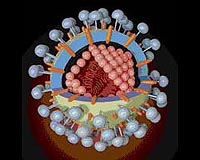| . |  |
. |
Toronto, Canada (SPX) Mar 02, 2010 The flowering plant - purple loosestrife - has been heading north since it was first introduced from Europe to the eastern seaboard 150 years ago. This exotic invader chokes out native species and has dramatically altered wetland habitats in North America. But it turns out it may have a vulnerability after all: the northern climate. Canadian scientists have found that adapting to the Great White North carries a severe reproductive penalty that may limit its spread. Purple loosestrife (Lythrum salicaria) destroys wildlife habitats by displacing native vegetation that provides food, shelter, and breeding areas for wildlife. In urban areas, it invades ditches where it can block or disrupt water flow. It has few pests and diseases, resists various control methods, and plants can produce as many as 3 million seeds a year. But as this invasive plant has spread north it has run into challenges posed by a shorter growing season, according to a study conducted by Robert Colautti, who recently obtained his Ph.D. from the University of Toronto's Department of Ecology and Evolutionary Ecology. The results are published online this week in the Proceedings of the Royal Society of London, series B and featured in Nature. The authors used modeling and experimental studies of 20 purple loosestrife populations along a 1200 km latitudinal gradient from Maryland to Timmins, Ontario, representing a one-month difference in growing season. They found that northern populations have become locally adapted and flower earlier in response to a shorter growing season. However, early flowering plants suffer a cost in terms of smaller size and reduced seed production. The reason: a genetic constraint. "Genes that cause early flowering also reduce plant size, so early flowering and small size evolve together," says Colautti. "Smaller size results in lower seed production, which is likely to limit the spread of purple loosestrife in northern regions." Co-authors of the study are Colautti's supervisor Professor Spencer Barrett of the Department of Ecology and Evolutionary Biology and Christopher Eckert of Queen's University. The research was funded by the Natural Sciences and Engineering Research Council of Canada, an Ontario Graduate Scholarship and a Premier's Discovery Award from the Ontario Government.
Share This Article With Planet Earth
Related Links University of Toronto Darwin Today At TerraDaily.com
 Scientists Reveal Driving Force Behind Evolution
Scientists Reveal Driving Force Behind EvolutionLiverpool, UK (SPX) Mar 02, 2010 The team observed viruses as they evolved over hundreds of generations to infect bacteria. They found that when the bacteria could evolve defences, the viruses evolved at a quicker rate and generated greater diversity, compared to situations where the bacteria were unable to adapt to the viral infection. The study shows, for the first time, that the American evolutionary biologist Leigh Va ... read more |
|
| The content herein, unless otherwise known to be public domain, are Copyright 1995-2010 - SpaceDaily. AFP and UPI Wire Stories are copyright Agence France-Presse and United Press International. ESA Portal Reports are copyright European Space Agency. All NASA sourced material is public domain. Additional copyrights may apply in whole or part to other bona fide parties. Advertising does not imply endorsement,agreement or approval of any opinions, statements or information provided by SpaceDaily on any Web page published or hosted by SpaceDaily. Privacy Statement |